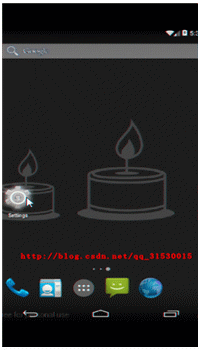一、DragLayer布局
上一篇文章分析过Launcher的布局,它是最外层的布局
<!-- Full screen view projects under the status bar and contains the background -->
<FrameLayout xmlns:android="http://schemas.android.com/apk/res/android"
xmlns:launcher="http://schemas.android.com/apk/res-auto/com.android.launcher3"
android:id="@+id/launcher"
android:layout_width="match_parent"
android:layout_height="match_parent"
android:background="@drawable/workspace_bg" >
<com.android.launcher3.DragLayer
android:id="@+id/drag_layer"
android:layout_width="match_parent"
android:layout_height="match_parent" >
<!-- The workspace contains 5 screens of cells -->二、DragLayer代码分析
官方解释为:A ViewGroup that coordinates dragging across its descendants.意思是说它是一个协调处理它的子view拖动的容器.那么很明显,我们需要关注它对屏幕触摸事件的处理.它有三个方法onTouchEvent,onInterceptTouchEvent和onInterceptHoverEvent.在分析这三个方法之前,先看下DragLayer的构造函数,它重写了FrameLayout的一些属性.
public DragLayer(Context context, AttributeSet attrs) {
super(context, attrs);
// 禁止多点触控
setMotionEventSplittingEnabled(false);
// 按指定顺序渲染子控件
setChildrenDrawingOrderEnabled(true);
// 侦听子view的add和remove事件
setOnHierarchyChangeListener(this);
//拖动图标到屏幕左边缘的图片
mLeftHoverDrawable = getResources().getDrawable(R.drawable.page_hover_left_holo);
//拖动图标到屏幕右边缘的图片
mRightHoverDrawable = getResources().getDrawable(R.drawable.page_hover_right_holo);
}我已经在代码写上了注释,mLeftHoverDrawable是拖动桌面上的图标到屏幕左侧边缘时显示的图片,默认的图片实现的是高亮的效果,这里我把它替换为手指的图片,便于观看效果,如下图








 本文详细分析了Android 4.4 Launcher中的DragLayer布局,它是负责处理子view拖动的ViewGroup。文章探讨了DragLayer的构造函数、触摸事件处理的关键方法onTouchEvent、onInterceptTouchEvent和onInterceptHoverEvent,以及其在屏幕事件传递中的角色。特别提到了handleTouchDown方法与clearAllResizeFrames方法在拖动和调整Widget大小中的作用。
本文详细分析了Android 4.4 Launcher中的DragLayer布局,它是负责处理子view拖动的ViewGroup。文章探讨了DragLayer的构造函数、触摸事件处理的关键方法onTouchEvent、onInterceptTouchEvent和onInterceptHoverEvent,以及其在屏幕事件传递中的角色。特别提到了handleTouchDown方法与clearAllResizeFrames方法在拖动和调整Widget大小中的作用。

 最低0.47元/天 解锁文章
最低0.47元/天 解锁文章

















 469
469

 被折叠的 条评论
为什么被折叠?
被折叠的 条评论
为什么被折叠?








